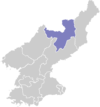- P'ungsŏ
-
P'ungsŏ Chosŏn'gŭl 풍서군 Hancha 豊西郡 McCune–Reischauer P'ungsŏ kun Revised Romanization Pungseo-gun Statistics Area 1,812 km2 (699.6 sq mi) Population (1991) 33,000 (est.) Population density 18.2/km2 (47.2/sq mi) Administrative divisions 1 ŭp, 4 workers' districts, 17 ri P'ungsŏ is a kun, or county, in Ryanggang province, North Korea. It was constructed after the division of Korea from portions of Pungsan and Kapsan.
Lying atop the southern portion of the Kaema Plateau, P'ungsŏ is heavily mountainous. In general, the mountains are higher in the northwest and lower toward the southeast. They include the Puksubaek range; the highest point is Puksubaeksan itself. The chief rivers are the Hochon and the Nunggwi (능귀강). P'ungsŏ Lake, an artificial reservoir, lies in the middle of the county. Some 91% of P'ungsŏ's area is covered with forestland.
Logging is the chief industry in P'ungsŏ. There is little agriculture, due to the rugged terrain. However, some amounts of maize, potatoes, and wheat are produced on dry-field farms; livestock are also raised. The county is known for the production of bracken fern. The county is home to deposits of gold, lead and zinc.
The county is served by road, but not by rail. The Nunggwi River and P'ungsŏ Lake are used to transport raw lumber downstream.
See also
External links
- (Korean) In Korean language online encyclopedias:
Ryanggang Capital 
Cities Counties Kapsan · Kimjŏngsuk · Kimhyŏnggwŏn · Kimhyŏngjik · Paegam · Poch'ŏn · P'ungsŏ · Samjiyŏn · Samsu · Taehongdan · UnhŭngCategories:- Counties of Ryanggang
Wikimedia Foundation. 2010.
